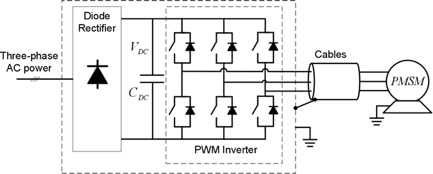Assessment Of Voltage Gradients / Magnitudes Observed Within Insulation Systems
Work Package Leader: Prof. Davide Barater
Objectives
To analyze and model the voltage gradients and the magnitudes observed in insulation systems for typical converter – cabling – machine systems. To assess the voltage distribution within a typical electrical machine also in function of key machine parameters.To identify measures that can be taken to reduce the voltage gradient at the electrical machine without compromising the performance of the power electronic converter.
Description
Typical converter – cabling – machine systems will be simulated within Matlab Simulink environment. For detailed simulations of system subparts, the use of SPICE is envisaged. The results will be compared with those obtained from experimental evaluations of the phenomena observed in a typical aerospace drive system. The experimental evaluations will be used to tune the parameters of the simulations in order to better match the real case application results.If any difference between simulations and experimental results will arise, an investigation for pursuing the physical explanation of the phenomenon will be conducted.
This task should include an assessment of the voltage distribution within a typical electrical machine and should examine the impact of key parameters such as the number of turns, the winding method used and the stator length. Reference will be made to stators manufactured with typical winding technology using commercial conductors and slot liners. State of the art analytical (or FEM, when appropriate) models will be used to derive the turn resistance and inductance, the turn/turn and turn/ground capacitance. The dynamic model thus achieved will be exploited to estimate the turn voltage distribution within the machine when subjected to surge voltages of various rise times.
Experimental measurements will be used to compare the results with the voltage distribution measured within different type of stator windings (mainly form wound and random wound coils)In particular, the analysis will focus at first on form wound winding. For random wound winding, to narrow the research frame, the worst-case scenario of the first turn close to the last turn of the coil will be considered.
The task should identify measures that can be taken to reduce the voltage gradient at the electrical machine without compromising the performance of the power electronic converter. The task will involve a survey of the current solutions and their impact on the global system efficiency, along with the analysis of new possible solutions to mitigate the effect of high voltage gradient on the insulation system of the electrical motor, without renouncing the advantages of efficiency and power density envisaged by wide-bandgap devices.
Performance of new possible solutions, mainly related to the use of multilevel converters, will be compared with those of differential filters. The comparison will focus on the following points:
- Weight
- Volume
- Power losses (which need always to comprehend inverter + electrical motor)
- Costs (part costs)
- Reliability
The activity will involve simulations in Matlab Simulink environment and FEM when appropriate

